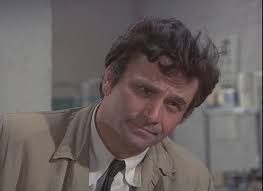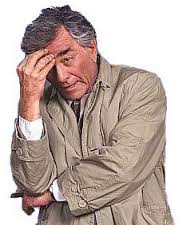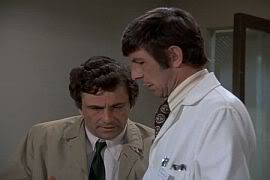

Note: A version of this article was published in 2015.
Peter Falks had two runs as Columbo. The first ran from 1971-78 over NBC as part of the network’s Mystery Wheel. Columbo returned in 1989 over ABC in a series of TV movies, with the last airing in 2003.
There were four key differences between the newer Columbo films and the originals:
1) Length
Most of the original Columbo films had a 90 minute time slot on air which made them about 70-75 minutes without commercials. The new Columbo films took up 2 hours and had a running time of approximately 90 minutes. I have to admit, in general, this was a case of “less is more.”
One key example was the second ABC Columbo, “Murder, Smoke, and Shadows” where the film started strong but dragged on too long and at the end of Columbo’s denouement we had (and I kid you not), the police coming out and doing a musical number when they announced the arrest.
The old Columbos worked because of their limitations. They didn’t go on forever, and when there was a longer case thrown in such as with, “A Friend Indeed,” the time was well-spent while the only new film that I think benefited from the longer running time was, “Agenda for Murder.”
2) More Adult Content
Columbo in the 1970s remains a tasteful family-friendly TV show. The latter Columbo had a lot more sex in the plot and a lot more skin on the screen. A few episodes featured lurid plots and disturbing murder scenes. Of course, this isn’t to say that all of the latter Columbos were strictly adult affairs but quite a few pushed the envelope.
With one exception, the added sexual content and violence tended to detract rather than add to Columbo. At its core, the strength of Columbo are great characters and their interactions, and the episodes that had the most adult content such as, “Uneasy Lies the Crown” and “Murder: A Self Portrait” tended to sacrifice quality for titillation. If there was an episode that seemed more “grown up” that did work, it was, “It’s All in the Game” starring Faye Dunaway as a suspect who is trying to seduce Columbo to keep him off her trail but that works because of the character interactions.
3) More Experimentation
Of the forty-four 1970s Columbo films, only one messed with the formula of Columbo being an inverted mystery (Season 5’s “Last Salute to the Commodore.”) Of the twenty-four revived shows, there were half a dozen different attempts to break with the formula. These variations ranged from following the killer up to the point of the murder and finding someone else had already committed the murder, not showing the murder and then planting doubt as to the killer’s guilt, and then there were two adaptations of Ed McBain novels.
“Last Salute to the Commodore” was one of my two least favorite 1970s episodes, but some of these later experiments aren’t too bad. “Rest in Peace, Mrs. Columbo” begins with the funeral of “Mrs. Columbo” and is told through flashback from the point of view of a woman seeking revenge on the good Lieutenant by murdering his wife. The McBain novel adaptation, “Undercover” is a fine thriller if you can get past the fact Columbo’s behavior is inconsistent with everything we know of the character. “Columbo Cries Wolf” also had some good moments,.
The other three are more problematic, but not for messing with the formula. Still, while some of the revived Columbos that go in other directions can be entertaining, they still can’t beat the best of the “normal” Columbo episodes.
4) Less Star Quality
The original Columbo was known for the amazing casting. Among the actors who played Columbo murderers in the old days were Anne Baxter, Robert Culp, Leonard Nimoy, Roddy McDowell, Martin Landau, Dick Van Dyke, Patrick McGoohan, Ricardo Montalban, Ruth Gordon, and so many more. Peter Falk was a fantastic actor and had great chemistry with so many guest stars and that chemistry made the 1970s episodes so memorable.
The new series had a virtual power outage, particularly in 1989 and 1990. Of the first eleven villains, the only actor in Falk’s league was McGoohan. The second best of the group was Fisher Stevens. That’s a big gap.
The series did get better guest stars between 1991-94 when Columbo cut back from 4-6 films a year to between 2 and 3 films. The results were among the best of the new run as Faye Dunaway was nominated for both an Emmy and a Golden Glove for her appearance. Dabney Coleman, George Hamilton, and Rip Torn turned in memorable and satisfying performances in their turns against Columbo.
Of course, not even a good guest star could save some films. A mustached William Shatner is miscast in Butterfly in Shades of Grey. Tyne Daley did the best she could with a fairly stereotypical flirty lush role in A Bird in the Hand but deserved far better as a Columbo villainess.
Conclusion
There did seem to be a fair share more stories in the later years that strained credulity in terms of motive or were plain derivative (i.e. “Strange Bedfellows.”)
Yet, the one thing that remained the same was Peter Falk. Some episodes felt like the only thing good in the movie was Columbo but almost always that still made it worth watching. There’s so much in every moment when Falk’s on the screen that he can carry the show by himself which was a good thing because he often had to.
By almost every measure, ABC’s Columbo was an inferior product to its predecessor, but it provided two dozen opportunities to see Peter Falk in action as his greatest character and that makes most of them worth viewing.
You can watch the 1970s episodes of Columbo on IMBD TV and all episodes of the series are available for viewing on Peacock.

